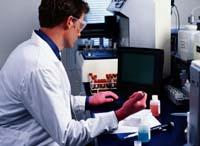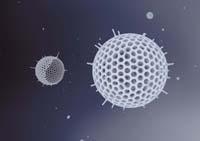Breast milk against AIDS
2005/11/20 Galarraga Aiestaran, Ana - Elhuyar Zientzia

Researchers already knew that breast milk contains anti-virus and antibacterial compounds. For example, it is known that the mother transmits antibodies to the child through milk. However, the AIDS virus manages to escape through different mechanisms.
Now they have discovered that the molecule is really effective, as they have checked in the laboratory that prevents infection. The molecule has been called Lewis X and is a glucid. In addition, in addition to milk, it is also found in saliva and blood, at a lower concentration than in milk.
However, according to UNICEF, more than two hundred thousand children are infected each year through breast milk. The World Health Organization therefore recommends that mothers with AIDS not breastfeed. Knowing this, the question arises: How can it spread during breastfeeding if the milk itself has a problem that prevents infection?

According to the researchers, if they did not have the Lewis X component, many more children with breast milk would be contaminated. In fact, only 10-20% of children who have a hiv-positive mother take the virus for two years. And researchers suspect it would be much more if the milk did not have Lewis X and other protective compounds.
However, this does not mean that hiv-positive mothers breastfeed children, but, as so far, health officials recommend hiv-positive mothers to give them formula.
Effective barrier
Although the presence of Lewis X molecules in breast milk is not enough to protect themselves from AIDS, researchers in Amsterdam have found it effective in preventing infection in the laboratory. They have also analyzed how it achieves this effect. It seems that the key lies in the strategy it uses to get into the cells that infect the AIDS virus.
AIDS infects some cells in the immune system: CD4 T cells. It enters the cells, reproduces them there and destroys them. As a result, the body is unprotected from pathogens, since CD4 T cells are fundamental in the immune system.

Although there are many aspects to clarify, researchers consider the virus to be associated with other CD4 T cells. These cells are also from the immune system and are called dendritic cells. The problem is that these cells are also associated with the Lewis X molecule, and then the AIDS virus has no place. Therefore, the CD4 T cell cannot be accessed.
In addition, dendritic cells are found mostly in tonsils, so it is very easy for Lewis X molecules to associate with them when the child takes milk. In some ways, Lewis X molecules leave the AIDS virus without taxi drivers and thus cannot access the cells it infects.
First steps
Researchers at the University of Amsterdam have recognized that research is in its beginnings. The ultimate goal is to test whether Lewis can become a component of X microbicides.
Microbicides are used in intercourse, in the vagina, to prevent contamination. Microbicides are used in cases where the condom is not desired, or in combination with it, to further reduce the risk of contamination. Researchers believe that Lewis X can be the ideal component of microbicides. If so, they will say that breast milk has nothing in common!
Published in 7K.




